danbricklin.com/log
|
||
|
|
Starting April 11, 2002
At the Red Sox game, Barney Stone, Nantucket Conference report, Kurzweil and Kertzman in Boston, Wireless at the Boston Marathon, Riding a Segway
11Apr02-16May02
2002_04_11.htm
|
|
|
At the Red Sox game [link]
A close friend of mine called late yesterday morning. He had an extra ticket to see the Red Sox play baseball last night, and wondered if I wanted to join him. I sure did! The Red Sox are doing great this year, and one of their best pitchers, Derek Lowe, was pitching.
The seats were great. They were right behind home plate. Sitting to our left were all these people taking notes -- scouts we assume from other teams or something.
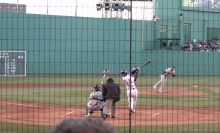 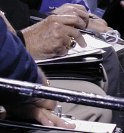 The view from my seat, scouts taking notes and one with a big ring that I hear is a World Series Ring -- this must be the job for players who did well
Many of the people in the section had a job to do: Raise a radar gun during each pitch. This woman apparently works for the TV station (another person held the one that drives displays around the ballpark, the scouts had their own, too):
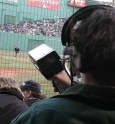  Woman holding radar gun and a speed displayed above the field for us to see
Far in Center Field I could see the TV cameras covering the game. During each pitch, the red lights came on on one of them, indicating it was live. I called Bob Frankston on my cell phone (Treo using earphone) and asked him to turn on his TV and see if he could see me. To help him locate me, I set my camera to "always flash" and told him when I took a picture. That made it easy for him to find me. (Rendezvousing takes interesting techniques.) He used the TV turner and recorder on one of his PCs and sent me these pictures:
 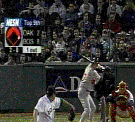  In the first picture you can see the cameras above the field behind the pitcher. One has the red lights, two show a reflection of my flash (!). The next picture is from Bob's PC, with a close up of me in my hat holding my camera taking a picture. (I put on the hat to help him find me.) Now that he knew where I was, the last one shows me from a replay later that night.
Boston won. (The recap in on the Red Sox web site.)
Barney Stone [link]
Last week I attended the Miva Corporation's conference for users and developers. Miva makes the leading eCommerce platform for small and medium sized businesses, and is a Trellix partner. I ran into a person that many old-timers in the personal computer industry probably remember and would appreciated seeing in a photo: Barney Stone. Barney was the designer and co-author of DB Master, the relational database program for the old Apple II. (Look for DB Master, number 14 on this history page.) His old company was Stoneware, as I recall. His current company is Stone Edge Technologies. Among other things, they sell a client-side application that helps you use Miva's products. Here's what he looks like today (first two pictures):
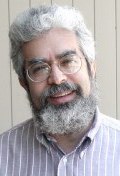 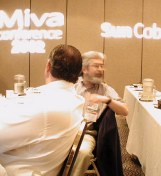  We look the same as we used to, except for the gray many of us are showing. Barney Stone's smile is the same, as I recall. The person with the mike is Joe Austin of Miva.
Miva's CEO Joe Austin introduced me as a computer pioneer before my talk. When I got up, I told everyone how we had another pioneer in our midst, one whose product related to small business and record keeping, just like the products many of them are working on today. Upon mentioning DB Master, someone next to Barney turned to him and said "Wow! I used to sell lots of DB Master in the old days..."
Nantucket Conference report [link]
I finally had time to finish my report about the Nantucket Conference. Read "Nantucket Conference 2002".
Nantucket Conference [link]
I'm attending the Nantucket Conference for the third year. I'll be posting some observations sometime next week. For those that got here following Dan Gillmor's link in his comments hoping to find some pictures and my observations, you can look at the beginnings of my report on this page. (No comments, just pictures.)
Kurzweil and Kertzman in Boston [link]
Last week, two people with last names containing "K" and "z" spoke in the Boston area. Ray Kurzweil and Mitchell Kertzman both spoke at a Massachusetts Software and Internet Council meeting, and Mitchell also spoke that evening at a Combined Jewish Philanthropies Tech20 event. I was the one who introduced Ray. I pointed out how his work usually involved digital technology applied to the most undigital parts of the physical world. I also pointed out how long some of his work has lasted. For example, the omni-font optical character recognition software he pioneered 29 years ago is still being sold (in a later, but derivative version) with many scanners (now as "Textbridge"). The sampled sound music synthesis he pioneered 18 years ago with the Kurzweil 250 piano is still a major way instruments are created electronically.
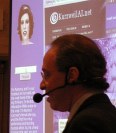  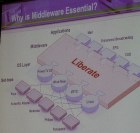 Ray Kurzweil conversing with his virtual alter-ego Ramona on the KurzweilAI.net web site, Mitchell Kertzman telling a story, slide from his presentation about his company
Here are just a few points.
From Ray: There is increasing software content is just about everything. Even our chairs have a high software content, as software is used in the design and control of manufacturing. "Software content is going to approach 100%" he claimed. This fits with his vision of the emergence of more and more use of virtual worlds to complement, augment, or replace the physical world.
Mitchell, during his talk about how his company, Liberate, is building a platform for implementing interactive TV, related this anecdote: When the WebTV people were demoing early WebTV to him years ago, they showed how you could browse the web on a TV and do other things just like on a PC, and then they showed him another feature. They proudly said: "This is our screen saver." And there it was, just like on a PC. Mitchell was struck how they didn't understand TV. He exclaimed to us: "The screen saver of TV is TV."
Wireless at the Boston Marathon [link]
Monday was the Boston Marathon. As usual, I found an hour or so to watch and cheer on the runners. My report from two years ago pretty much says what it's like. As usual, I was in the middle of Heartbreak Hill.
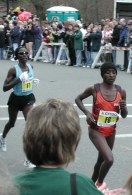 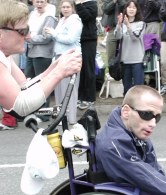  Lead women who went on to break the course record, Dick Hoyt pushing his son Rick (who has cerebral palsy) as he has for over 20 years (this is a better picture than in my old report), a runner stopping to say hi to a friend showing the electronic tag in the laces
I noticed an interesting use of wireless, sponsored by Nextel. To help time each runner, and to verify that they indeed did run the whole race, electronic tags from ChampionChip are loaned to each racer. (The Boston Athletic Association will sell you one with a nice logo if you want to keep one -- ChampionChip lists logo'ed ones from the Marine Corps, the LA Marathon, and others on their web site.) As each runner crosses the starting line, lots of check points, and finally the finish line, their time is logged. Nextel let each runner specify up to six email addresses (up from two last year) to which to send an email immediately after each crossing giving the time and estimated arrival at the finish. Of course, these emails could be to cell phones (hopefully Nextel ones...) of loved ones trying to cheer you on at various places. (With careful planning you can see someone along the way and use public transportation to meet them at the finish, too.) Now this is a good use of wireless: Very meaningful, timely, personal data, not couch-potato entertainment, with a broad definition of wireless. True mobile communications.
Riding a Segway [link]
Earlier this week I had the opportunity to use a Segway HT. It was during a conference attended by senior executives from various Fortune 1000 companies. I was one of the dozen or so speakers, and Segway Senior VP of Marketing Gary Bridge was another. Gary brought along three Segways (also known as a "Ginger") and a couple of people to help him do demonstrations.
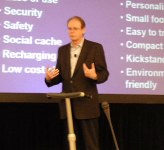 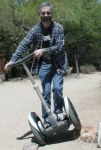 Gary speaking, me going over some rocks
I made sure that I got to spend time on one of the units whenever I could. Over the two day period the Segways were available, I probably logged over 2 hours of use. I wrote a report that covers what happened and what I learned from the experience. They are amazingly stable and rugged. They are nothing like a bike or scooter.
|
||
|
© Copyright 1999-2018 by Daniel Bricklin
All Rights Reserved.
|
||